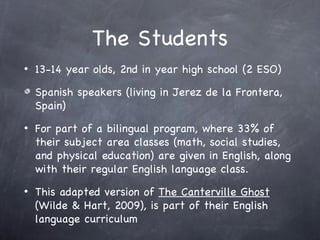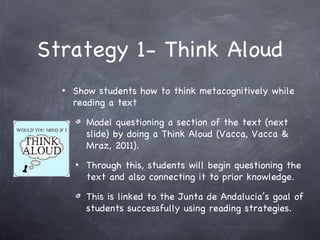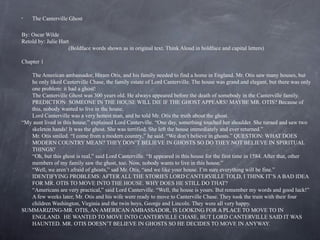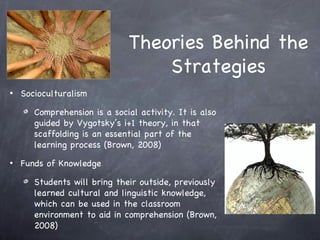Engaging Students with Texts
- 1. The Canterville Ghost Lesson created for Level 2 English Learners By: Leslie Goldsberry
- 2. The Students ŌĆó 13-14 year olds, 2nd in year high school (2 ESO) Spanish speakers (living in Jerez de la Frontera, Spain) ŌĆó For part of a bilingual program, where 33% of their subject area classes (math, social studies, and physical education) are given in English, along with their regular English language class. ŌĆó This adapted version of The Canterville Ghost (Wilde & Hart, 2009), is part of their English language curriculum
- 3. Junta de Andaluc├Ła: Standards for 2 ESO Bilingual Students Standards for 2 ESO Bilingual Students ŌĆó Comprehension of specific and general information in different texts, in print and digital, authentic and adapted, about familiar subjects and related to other content areas. Use of reading comprehension strategies: identification of text theme, with help from textual and non-textual elements; utilization of previous knowledge of the theme; inferencing meaning from context, from visual elements, from comparing similar words and phrases in the languages students already know.
- 4. Lesson Objectives ŌĆó Students will be able to identify the questions they have about the text, and also relate it to past experiences. Using metacognition, students will identify the sources of answers to questions using QAR. ŌĆó Students will be able to evaluate text more profoundly by predicting and engaging the text using an IEPC chart Students will be able to defend assumptions from text through double reading logs and resolve doubts using the group collective knowledge.
- 5. Strategy 1- Think Aloud ŌĆó Show students how to think metacognitively while reading a text Model questioning a section of the text (next slide) by doing a Think Aloud (Vacca, Vacca & Mraz, 2011). ŌĆó Through this, students will begin questioning the text and also connecting it to prior knowledge. This is linked to the Junta de AndaluciaŌĆÖs goal of students successfully using reading strategies.
- 6. ŌĆó The Canterville Ghost By: Oscar Wilde Retold by: Julie Hart (Boldface words shown as in original text. Think Aloud in boldface and capital letters) Chapter 1 The American ambassador, Hiram Otis, and his family needed to find a home in England. Mr. Otis saw many houses, but he only liked Canterville Chase, the family estate of Lord Canterville. The house was grand and elegant, but there was only one problem: it had a ghost! The Canterville Ghost was 300 years old. He always appeared before the death of somebody in the Canterville family. PREDICTION: SOMEONE IN THE HOUSE WILL DIE IF THE GHOST APPEARS! MAYBE MR. OTIS? Because of this, nobody wanted to live in the house. Lord Canterville was a very honest man, and he told Mr. Otis the truth about the ghost. ŌĆ£My aunt lived in this house,ŌĆØ explained Lord Canterville. ŌĆ£One day, something touched her shoulder. She turned and saw two skeleton hands! It was the ghost. She was terrified. She left the house immediately and ever returned.ŌĆØ Mr. Otis smiled. ŌĆ£I come from a modern country,ŌĆØ he said. ŌĆ£We donŌĆÖt believe in ghosts.ŌĆØ QUESTION: WHAT DOES MODERN COUNTRY MEAN? THEY DONŌĆÖT BELIEVE IN GHOSTS SO DO THEY NOT BELIEVE IN SPIRITUAL THINGS? ŌĆ£Oh, but this ghost is real,ŌĆØ said Lord Canterville. ŌĆ£It appeared in this house for the first time in 1584. After that, other members of my family saw the ghost, too. Now, nobody wants to live in this house.ŌĆØ ŌĆ£Well, we arenŌĆÖt afraid of ghosts,ŌĆØ sad Mr. Otis, ŌĆ£and we like your house. IŌĆÖm sure everything will be fine.ŌĆØ IDENTIFYING PROBLEMS: AFTER ALL THE STORIES LORD CANTERVILLE TOLD, I THINK ITŌĆÖS A BAD IDEA FOR MR. OTIS TO MOVE INTO THE HOUSE. WHY DOES HE STILL DO THAT? ŌĆ£Americans are very practical,ŌĆØ said Lord Canterville. ŌĆ£Well, the house is yours. But remember my words and good luck!ŌĆØ A few weeks later, Mr. Otis and his wife were ready to move to Canterville Chase. They took the train with their four children Washington, Virginia and the twin boys, George and Lincoln. They were all very happy. SUMMARIZING-MR. OTIS, AN AMERICAN AMBASSADOR, IS LOOKING FOR A PLACE TO MOVE TO IN ENGLAND. HE WANTED TO MOVE INTO CANTERVILLE CHASE, BUT LORD CANTERVILLE SAID IT WAS HAUNTED. MR. OTIS DOESNŌĆÖT BELIEVE IN GHOSTS SO HE DECIDES TO MOVE IN ANYWAY.
- 7. Strategy 2- QAR ŌĆó This strategy goes along with the Think Aloud, but ŌĆ£make explicit to students the relationships that exist among the type of question asked, the text, and the readerŌĆÖs prior knowledgeŌĆØ (Vacca et al, 2011, p. 200). ŌĆó This metacognitive thought building activity helps students understand where answers are found in texts or outside of them, something I see my students struggle with. ŌĆó This can be used with the activites section in the book.
- 8. Strategy 3- IEPC ŌĆó Help readers become more involved in the text by using an Imagine, Elaborate, Predict, and Confirm (IEPC) chart (Vacca et al., 2011). This is useful for struggling readers by more deeply involving them in the story and helping them identify their own issues in comprehension. ŌĆó Readers draw on imagery, and further develop reading strategies as a class and individually (See page 186 in Vacca et al. for more explanation)
- 9. Strategy 4-Double Entry Reading Logs ŌĆó These logs can be used to review plot or vocabulary from the story. Through this activity, students will be focused on key aspects of the story and have to defend their inferences of what is happening or definition of a word. ŌĆó A reading log can also help students comprehend specific and general information at a greater level by confirming their assumptions about the story.
- 10. Theories Behind the Strategies ŌĆó Socioculturalism Comprehension is a social activity. It is also guided by VygotskyŌĆÖs i+1 theory, in that scaffolding is an essential part of the learning process (Brown, 2008) ŌĆó Funds of Knowledge Students will bring their outside, previously learned cultural and linguistic knowledge, which can be used in the classroom environment to aid in comprehension (Brown, 2008)
- 11. References ŌĆó Brown, R. (2008). Strategy matters: Comprehension instruction for older youth. InK. A. Hinchman, H. K. Sheridan-Thomas, D. E. Alvermann, (Eds.), Best Practices in Literacy Instruction. The Guilford Press, pgs. 114-131. ŌĆó Ferrario, K. (n.d.) Think Aloud Metacognitive Strategy [PowerPoint ║▌║▌▀Żs]. Junta de Andaluc├Ła Consejer├Ła de Educaci├│n. Curr├Łculo integrado de las lenguas: Propuesta de secuencias did├Īcticas [Brochure]. Retrieved on March 18, 2012 from http://www.juntadeandalucia.es/averroes/averroes/html/portal/com/bin/contenidos/B f ŌĆó Vacca, R. T., Vacca, J. L., & Mraz, M. (2011). Content area reading: Literacy and learning across the curriculum (10th ed.). Boston: Pearson. ŌĆó Wilde, O. & Hart, J. (2009). The Canterville ghost. Cyprus: Burlington Books.
- 12. NAME: Your Comments (Justification for Score self-assessment) 4/3 2/1 Description of how literacy is Integration clearly and explicitly uses literacy Integration of literacy is unclear or integrated into content area concepts/strategies for promotion of studentsŌĆÖ not explicit construction of content understanding(s) Strategies for engagement Each of 3 strategies is explicitly described in Strategies are vague detail Learning Outcomes (LOs) Each of 3 LOs has a clear cognitively LOs focus on lower-level thinking engaging process (verb) and aligns with the skills and/or are not aligned with the strategy with which it is associated strategies Rationale Rationale for each of the strategies selected Rationale for each of the strategies explicitly describes how content will be is not clear as to how it will promote understood, as opposed to following a content understanding standard or transmitting information Learning Theory Learning Theory is used to explain each Learning theory is noted tangentially strategy










![References
ŌĆó Brown, R. (2008). Strategy matters: Comprehension instruction for older
youth. InK. A. Hinchman, H. K. Sheridan-Thomas, D. E. Alvermann, (Eds.),
Best Practices in Literacy Instruction. The Guilford Press, pgs. 114-131.
ŌĆó Ferrario, K. (n.d.) Think Aloud Metacognitive Strategy [PowerPoint ║▌║▌▀Żs].
Junta de Andaluc├Ła Consejer├Ła de Educaci├│n. Curr├Łculo integrado de las
lenguas: Propuesta de secuencias did├Īcticas [Brochure]. Retrieved on
March 18, 2012 from
http://www.juntadeandalucia.es/averroes/averroes/html/portal/com/bin/contenidos/B
f
ŌĆó Vacca, R. T., Vacca, J. L., & Mraz, M. (2011). Content area reading:
Literacy and learning across the curriculum (10th ed.). Boston: Pearson.
ŌĆó Wilde, O. & Hart, J. (2009). The Canterville ghost. Cyprus: Burlington
Books.](https://image.slidesharecdn.com/goldsberrylengagingstudentswithtext-120527190136-phpapp02/85/Engaging-Students-with-Texts-11-320.jpg)
